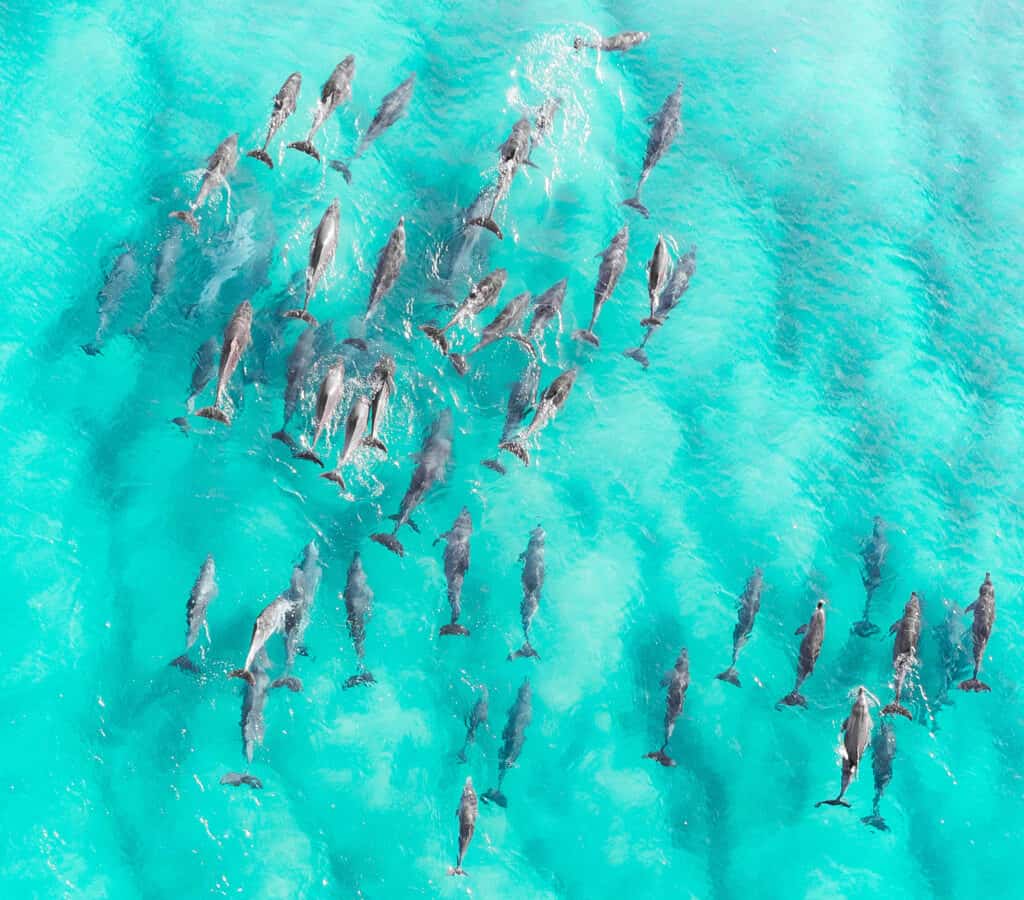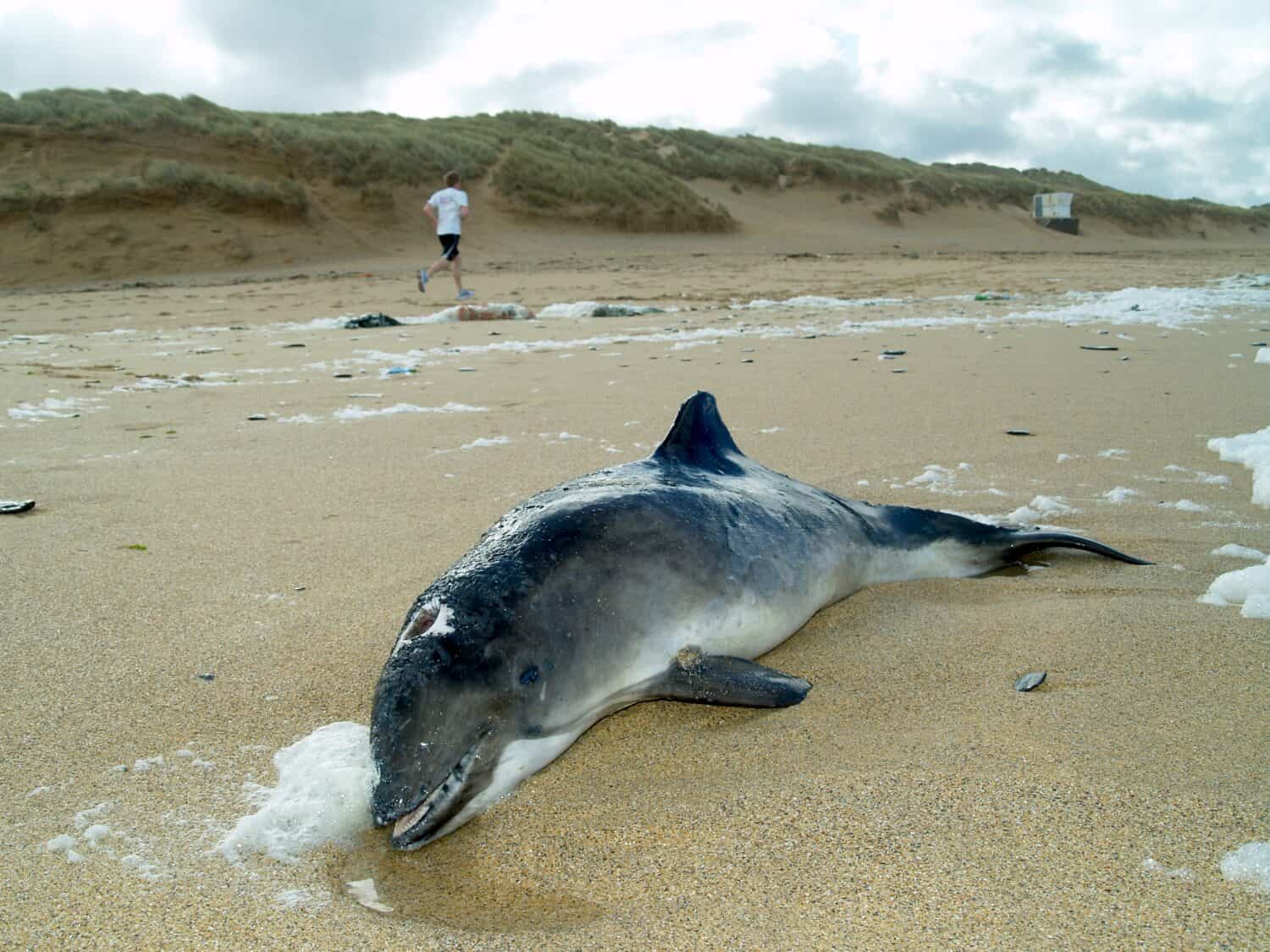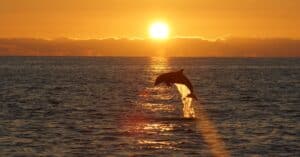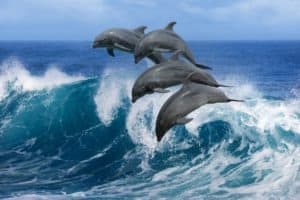Found in all the oceans of the world, the dolphin, an iconic symbol of oceanic grace, harbors an array of behaviors and experiences that stretch far beyond its playful leaps and chatter. One such intricate aspect of their lives is reproduction. For dolphins, this process is deeply entangled with their social structures. Structures that are increasingly impacted by human activities. What does the mating dance of dolphins look like? How do environmental challenges, especially the anthropogenic ones (those due to humans), affect these marine mammals? Dive in as we explore these compelling questions.
What Are Dolphins, Anyway?
Before plunging into the depths of dolphin reproduction, let’s briefly sketch out the background of these fascinating creatures. Dolphins are members of the infraorder (the taxonomic category below suborder) Cetacea, a diverse group that also includes whales and porpoises. With families that run the gamut from oceanic dolphins (Delphinidae) to river dolphins (Platanistidae and Iniidae, with the Baiji likely extinct or on the cusp of extinction), dolphins present a rich biological diversity for study.

Though dolphins have a distinct look, their features vary greatly. The Taiwanese Indo-Pacific humpback dolphin, often referred to as the white dolphin, is a case in point.
©Aleksei Verhovski/Shutterstock.com
Social Structure and Reproductive Choices
When it comes to complex social dynamics, dolphins are the ocean’s virtuosos. They are not lone voyagers but social beings that live in pods that mirror the layered nuances of human society. You know, those cliques, hyperlocal collectives, and digital clusters of affinity across Discord servers, subreddits, and so forth. But let’s steer away from the abstract and plunge into the specifics. One of the most intriguing facets that mold the contours of dolphin communities is their intricate mating systems, a blend of biology, social hierarchy, and perhaps even dialectic frolic.
The Basic Structure of Pods and Dominance
Typically, dolphins live in pods, ranging from small family units to larger associations that can include hundreds of members. Within these pods, social hierarchies often emerge. Imagine a fluid pyramid, with dominant males typically ascending to the top echelons. These alpha males, characterized by their aggressive behavior and distinctive physical features, often get the first pick when it comes to choosing mates.
Layers Upon Layers of Social Choice
While the dominant males may seem to hold the proverbial “conch shell,” dolphin society interjects layers of complexity into the mix. For one, female dolphins aren’t passive actors in this mating game. They possess agency, often exercising their choice and showing preferences for certain mates. This might be based on a male’s ability to provide protection, or even more nuanced factors like social compatibility.
Furthermore, dolphins engage in what’s termed “coalitional alliances.” Male dolphins often form alliances with other males to secure access to females, turning the quest for mating into a collaborative venture. It’s like a high-stakes game of strategy, played not in isolation, but as part of a syndicate. These alliances can be fluid or stable, lasting for years and defining the social dynamics of entire pods.
The Social Role of Kinship
In addition to alliances, kinship plays a subtle but vital role in shaping reproductive choices. Lineage and familial ties can influence alliances, mate choices, and even the hierarchical arrangement within the pod. In some cases, daughters inherit the social standings of their mothers, creating generational threads that weave through the social fabric of the pod.
Polygamy and Multiple Partners
Most dolphin species practice polygamy, wherein both males and females engage with multiple partners during a single breeding season. This strategy enhances genetic diversity within the pod, adding a layer of resilience to the community.

While dolphin pods generally range from a handful to 30 or so, depending on the species and situation, a group of over 100,000 dolphins were spotted in February 2012 north of San Diego, California.
©F Photography R/Shutterstock.com
Unpacking Homosexuality in Dolphins
The intricate social dynamics of dolphins have always captivated the minds of both scientists and ocean enthusiasts alike. One facet that sparks particular interest is the prevalence of homosexual behavior within dolphin communities. But let’s be clear: This isn’t merely a passing oddity or a ripple in the ocean’s vast closet. This behavior opens up a broad discourse that veers into the realms of social structure, behavioral ecology, and even psychological dimensions.
Not Just a Passing Phase
Homosexual behavior in dolphins is neither scarce nor incidental. These highly social creatures engage in same-sex interactions that range from genital stimulation to mounting and even long-term partnerships. While the physical acts are easy to describe, the underpinnings of these behaviors are anything but simplistic.
The Ill-Understood But Oft-Observed Role of Homosexuality in Dolphins
So, what’s the driving force behind such behavior? Well, the jury’s still out on defining a singular, primary role. However, several theories underscore the multi-functional aspects of homosexuality in dolphins. For starters, these interactions may establish social hierarchies or dominance within a group. By engaging in same-sex behavior, dolphins create a social metric that can, in some instances, determine their standing within the pod.
A Human Corollary: The Greek Notion of Paideia
Drawing parallels between human and dolphin societies can be a risky endeavor, but one intriguing connection lies in the ancient Greek concept of Paideia. This was a complex educational and cultural practice, primarily undertaken by the aristocratic class, aimed at cultivating well-rounded individuals with intellectual, moral, and physical virtues. Just as the aristocracy in ancient Greece was tasked with instilling the ideals of kalos kagathos, meaning the “beautiful and good,” in its citizens, so too might dominant dolphins play a role in shaping social norms within their communities.
Paideia was not just about memorizing facts or learning skills. It was a formative process, a cultural medium through which individuals were groomed to become intellectually respectable and democratically engaged citizens. The Athenian educator Isocrates emphasized this, aiming to encourage wisdom and consistency on individual, civic, and panhellenic levels. The teachings involved liberal arts, science, gymnastics, and music, embodying the principle of “know thyself” and advocating moderation.
Making the Connection: Wisdom in the Waves?
If we transpose this concept onto dolphins, the complexity of homosexual behavior serves as a form of social Paideia. In essence, it becomes a process through which dolphins may be “educating” one another about social norms, hierarchies, and possibly even moral codes within their aquatic societies. It’s a shaping force, one that doesn’t just carve out individual roles but molds the collective consciousness of the pod. Like the Greeks’ holistic approach to individual and civic wisdom, dolphins may be using complex social behaviors to build a more cohesive, cooperative pod structure.
While the waters are still too murky to attribute purpose to such behavior in dolphins, its social implications could be profound. Whether or not dolphins consciously “intellectualize” these acts is a question for future research. But what’s undeniable is the depth of complexity within their social relationships.
Moreover, this behavior has been observed to reduce tension or aggression among pod members. Think of it as a form of social lubricant, an intimate activity that fosters cohesion and tempers high-strung emotions. Toned down human correlates might involve an arm-wrestling contest instead of a fist fight to resolve disagreement (probably the only time macho men will willingly hold hands). In any case, for dolphins that live in a world where survival often hinges on cooperation, these gender-blind acts serve as a tension dissipator, ushering in a sense of balance and community.

The intense baby calf-mother dolphin bond is essential for dolphin social development, a key tool for their survival.
©iStock.com/NaluPhoto
The Act of Mating
Dolphin mating is a brief but fascinating affair that isn’t seasonal, but year-round. Males vie for the attention of females through acrobatic displays or tail slaps on the water’s surface. Once mutual interest is established, the pair engages in a belly-to-belly copulation that lasts mere seconds but leaves a lasting impact on the pod’s future.
The Dance of Creation: Pregnancy and Motherhood in Dolphins
The journey of life for dolphins is a marvel that begins long before they grace our oceans with their playful leaps and chatters. It’s a saga deeply rooted in the intricate biological rhythms of pregnancy and motherhood, stages that reflect not just the complexity of marine mammal physiology, but also the profound emotional bonds forged between mothers and their young.
Gestation: One Year in the Womb
Picture this: A dolphin’s womb serves as a sanctuary for about 12 months, a period filled with the delicate orchestration of biological processes. This year-long gestation period, which can sometimes be only nine months, allows for the development of vital organs, the fortification of the immune system, and the sculpting of those agile forms capable of maneuvering through their watery realms. For the mother, it’s a time of heightened nutritional needs and altered social interactions within her pod, as she prepares to bring new life into the fold.
The Grand Entrance: Tactical Tail-First Birth
When it’s time for the new arrival, the event isn’t left to chance. Dolphins employ a carefully orchestrated tail-first birthing technique, a method purposefully designed to reduce the risk of drowning during those critical first moments of life. Imagine the moment: as the calf emerges, its tail flukes are the first to greet the world, providing it with the necessary propulsion to swiftly reach the water’s surface for its inaugural breath.
The Liquid Gold: Nursing and Bonding
But the journey has only just begun. Nursing extends for up to two years, a remarkable commitment in the animal kingdom. This period is not just about nutritional sustenance; it’s also an intimate phase that cements the bond between mother and calf. Mother’s milk is a cocktail of essential nutrients and antibodies, serving as the calf’s first line of defense in a world fraught with challenges. The act of nursing itself is more than a mere transfer of nourishment—it’s a tactile and emotional exchange that lays the foundation for social learning and enduring familial ties.
The Invisible Threads: Emotional and Social Connections
Moreover, this early period sets the stage for the calf’s social integration within the dolphin community. Mothers often introduce their young to pod members, encouraging interactions that offer lessons in social dynamics and survival skills. Such early experiences can have lasting implications for the calf’s social standing and behavior later in life.

Dolphins end up stranded ashore due to old age, sickness, and injury. In the case of calves, such as the one pictured here, the combination of their curious nature and the prevalence of fishing nets pose grave dangers.
©JANUSZ KONARSKI/Shutterstock.com
Human Impact and Environmental Challenges
The Stranding Crisis
Human activities, including pollution, fisheries interactions, and boat strikes, significantly contribute to marine mammal strandings. Coastal and estuarine species are particularly vulnerable due to their proximity to human activities like fishing and tourism.
Injuries and Behavioral Changes
Such human interactions often result in injuries, entanglements, and behavioral changes in marine mammals, further jeopardizing their reproductive success.
Navigating Troubled Waters: Why Robust Data Metrics Matter in Marine Ecology
Climate change looms large, leaving no aspect of our planet untouched. Yet, amidst this global crisis, the mysterious world of marine mammal strandings, especially dolphins, cries out for deeper scrutiny. Our traditional methods of monitoring these strandings are outdated and unreliable, plagued by ad-hoc practices and sporadic funding. These glaring inadequacies press us to think beyond current limitations and to usher in innovative approaches for more accurate data collection.
The Current State of Marine Stranding Data
Let’s begin by peeling back the layers of existing data collection methods. Marine mammal stranding networks serve as crucial tools to understand these baffling phenomena. However, these networks suffer from crippling inconsistencies. Hindered by erratic funding and inadequate infrastructure, they generate data that is both incomplete and underreported. It’s not just a matter of inefficient collection; this inconsistency hampers the validity of any ecological insights we might glean.
The Call for Reinvention: Emphasizing Alternative Metrics
The spotlight now turns to the growing chorus for change, a chorus that emphasizes the need for alternative metrics. The pitfalls of relying solely on public reporting are clear; it’s a shaky foundation that leaves room for error and subjective interpretation. That’s why there’s a pressing need for data collection methods that are not only more systematic but also more reliable.

The impact of oil spills on marine life is near-impossible to quantify. But the qualitative terms are asymptotic.
©Tigergallery/Shutterstock.com
The Deepwater Horizon Spill: A Wake-up Call
The Deepwater Horizon Oil Spill exemplifies the urgency of this issue. This devastating event triggered a surge in dolphin strandings in the Northern Gulf of Mexico, spotlighting our unpreparedness in ecological monitoring. Not only did the spill wreak havoc on the marine ecosystem, but the data also revealed unprecedented mortality rates among dolphins. And it doesn’t end there. Detailed studies, particularly in afflicted regions like Barataria Bay, uncovered serious health disparities among dolphins. The spill’s lingering impacts on dolphins’ immune systems were further evidenced by subsequent research.
What does this teach us? The Deepwater Horizon tragedy stands as a grim testament to the urgent need for rigorous data collection and monitoring systems. Such systems could offer a more transparent view into the ecological aftermath of similar disasters and guide timely interventions.
Mapping the Way Forward: Beyond Traditional Methodologies
So, what’s the next course of action? We’re at a pivotal intersection where necessity meets innovation. We need more than a band-aid solution; we need a complete overhaul of our current monitoring frameworks. Climate change, the unpredictable force that it is, further complicates the picture. The drive for alternative metrics isn’t just an academic discourse; it’s an operational imperative.
The Sum of All Parts: An Urgent Call to Action
The crisis in marine mammal stranding data collection isn’t an isolated issue. It’s part and parcel of a broader ecological challenge that requires our immediate attention. It’s time to move beyond the limitations of inconsistent funding and public reporting. We must invest in alternative, systematic metrics that can robustly assess the intricate realities of marine ecology, especially when cataclysmic events like oil spills threaten to distort them. By doing so, we equip ourselves with the tools needed to navigate the uncertain waters of our rapidly changing planet.
Conclusion
Why should we care about dolphin reproduction? The answer lies not just in its captivating interplay of social dynamics, biology, and environmental hurdles, but also in its relevance to human life. Dolphins navigate intricate social and mating systems, much like us. Yet they face a growing array of hazards, mainly stemming from human activities. Studying the impact of environmental degradation on these intelligent, social mammals serves as a cautionary tale for our own species, Homo sapiens. As we deepen our grasp of these marine animals, the urgency to address the human-made dangers they encounter intensifies. This knowledge not only serves as a call to action for their conservation but also prompts us to reflect on how we, too, can reduce the risks we pose to ourselves. The story of dolphin reproduction transcends mere scientific curiosity. It’s a compelling call to preserve life both below the ocean’s surface and above it.
The photo featured at the top of this post is © Elena Larina/Shutterstock.com
Thank you for reading! Have some feedback for us? Contact the AZ Animals editorial team.







